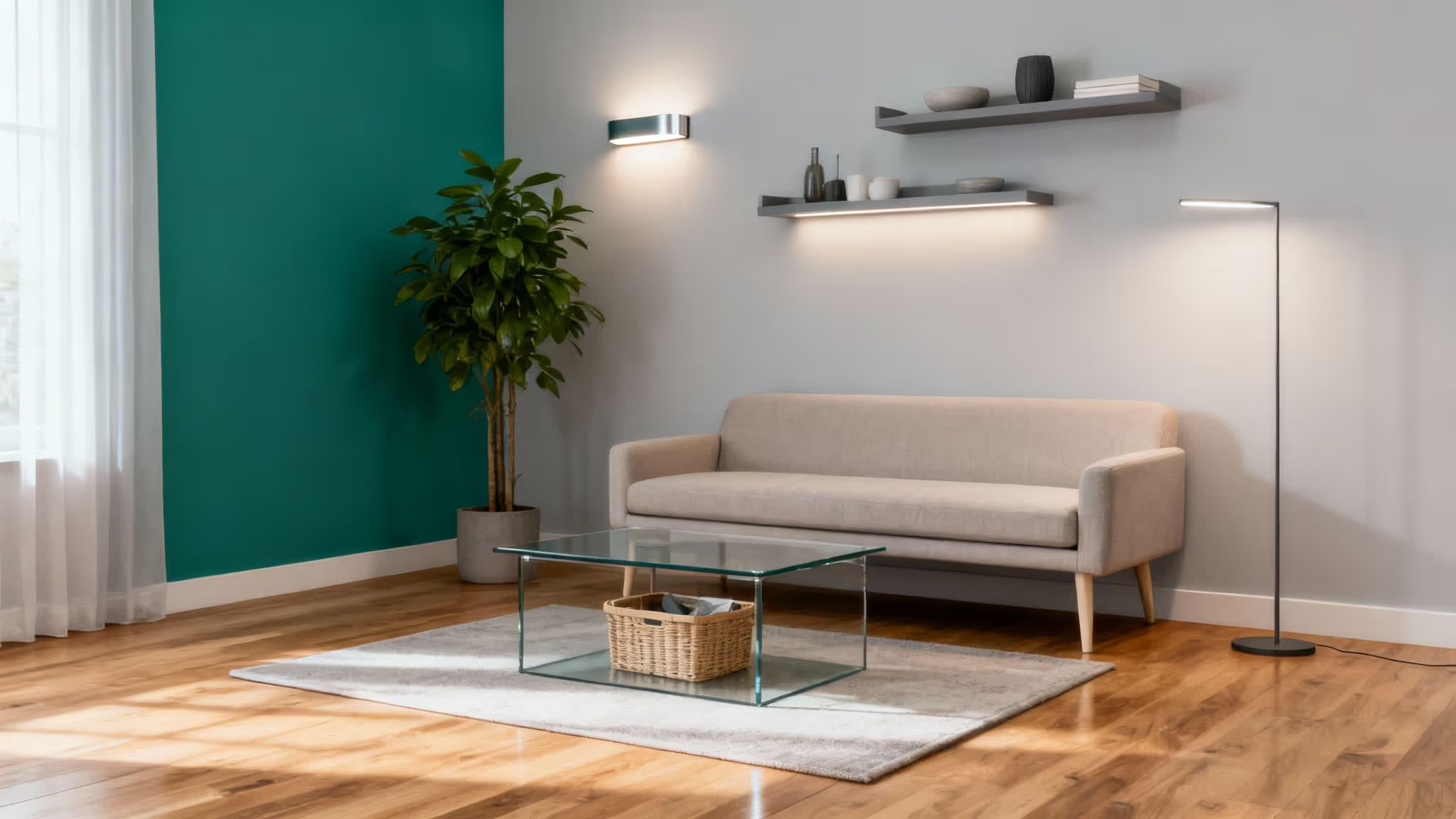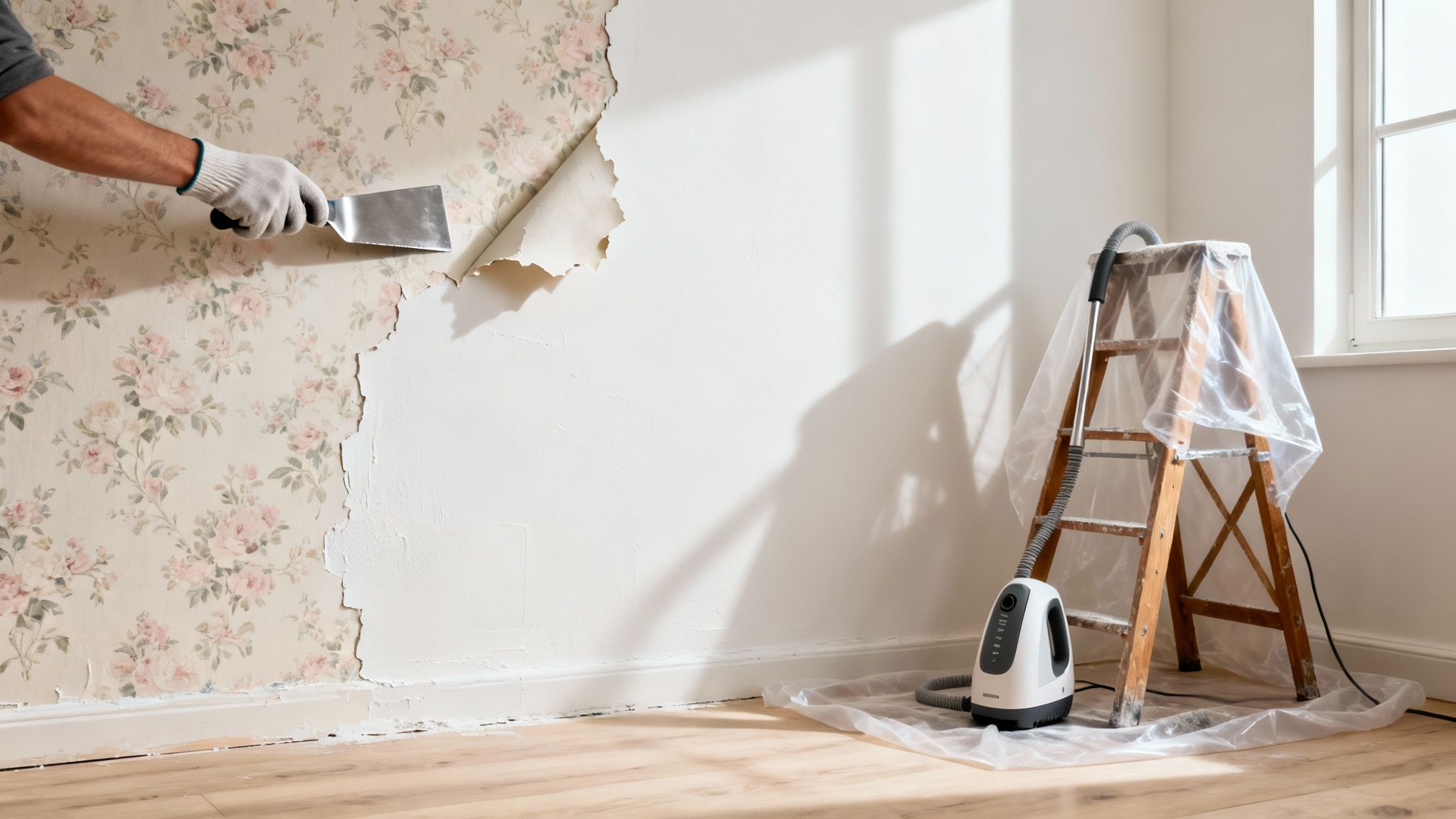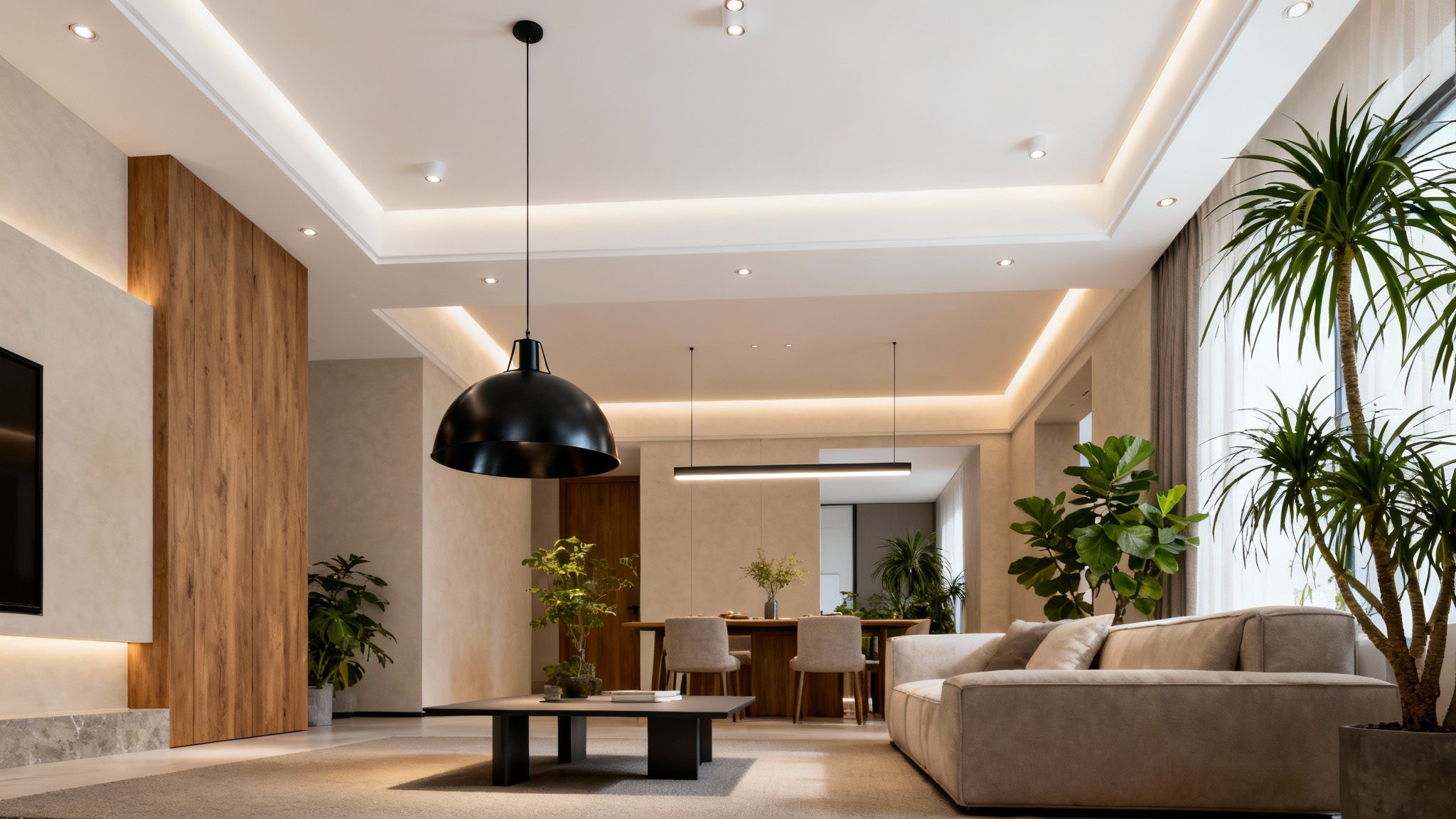When you’re staring at a small living room, the temptation is to jump straight to picking out furniture and paint colours. But if you want to get it right, the real magic starts with a solid plan. Before anything else, you need to master your layout. Get this right, and you'll create a room that flows beautifully and feels organised, not cramped.
A thoughtful floor plan is the blueprint for turning a tight space into a cosy and functional retreat.
Nailing the Layout in Your Small Living Room
Let’s be honest, getting the layout right is less about interior design wizardry and more about smart, practical thinking. It’s about creating a room that just feels right to be in every day, where you aren't constantly bumping into the coffee table. The right arrangement can make even the most compact room feel surprisingly spacious.
This is a familiar challenge for many of us, especially in the UK. With around 46% of UK households in flats or apartments, the average living room often sits between a snug 12 to 18 square metres. In spaces like these, a strategic layout isn't just a nice-to-have; it's everything.
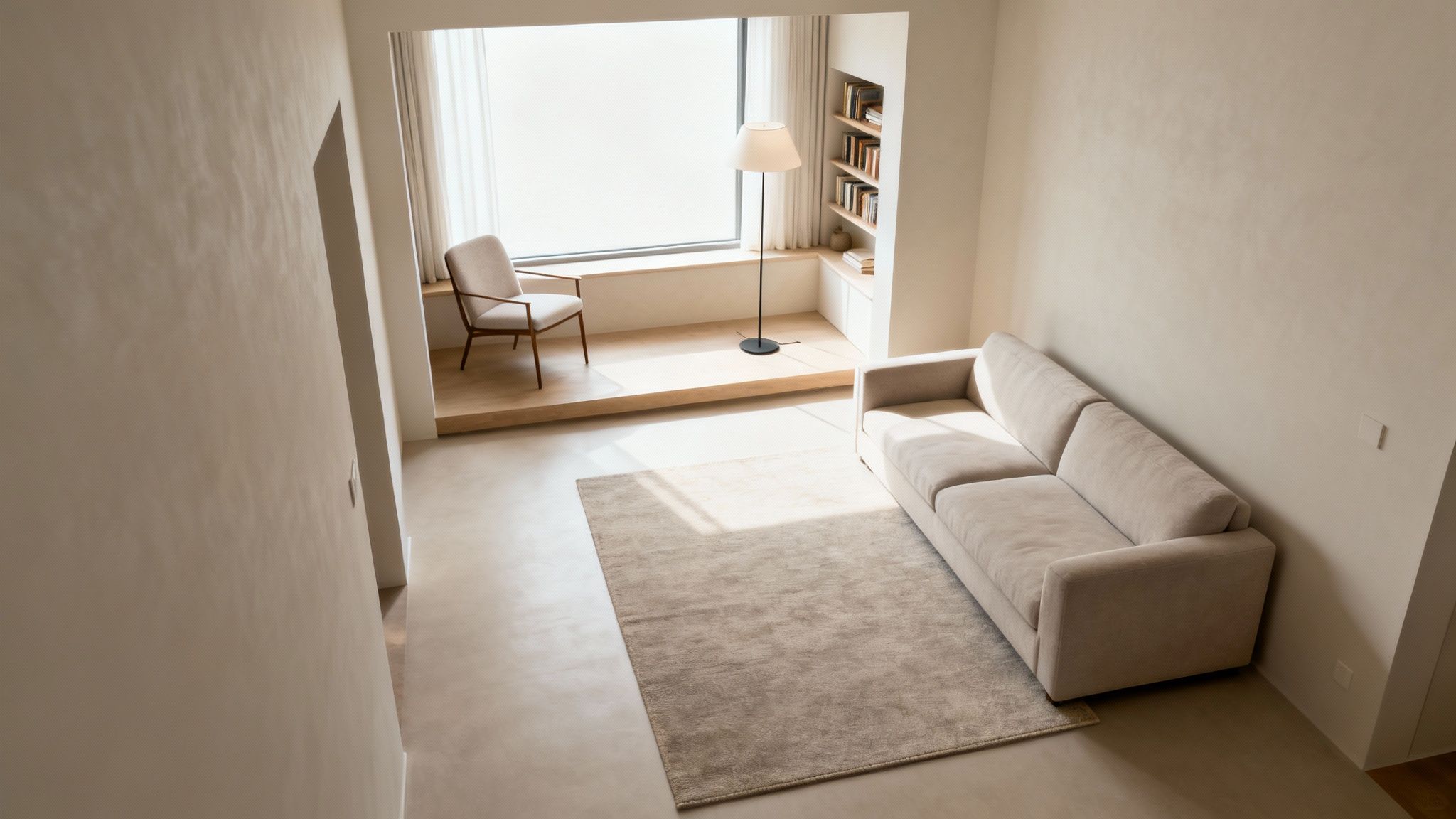
Map It Out and Find Your Focus
First things first: grab a tape measure. You need to know exactly what you're working with. Sketch out your room's dimensions, noting where the doors, windows, and any awkward nooks are. This simple step is non-negotiable—it’s what stands between a perfect fit and a sofa that won’t get through the door.
Next, identify the room’s focal point. What’s the first thing you notice when you walk in? It might be a beautiful fireplace, a big window, or the wall where the TV is destined to go.
Whatever it is, that’s your anchor. Your layout should celebrate this feature, not fight it. Arrange your main seating to face the focal point to give the room an immediate sense of purpose.
Create Clear Pathways and Zones
One of the quickest ways to make a small living room feel chaotic is by blocking the natural flow. You need to be able to walk through the space without turning sideways or navigating an obstacle course. As a rule of thumb, try to leave at least 75cm (about 30 inches) clear for the main pathways. It makes a world of difference.
Even in a tiny room, you can create the illusion of different zones. This is where an area rug becomes your best friend. Placing your sofa and armchairs on a large rug instantly defines the "lounge zone," grounding the furniture and making the whole arrangement feel more deliberate and pulled together.
For a deeper dive into clever arrangements, you can find more inspiration in our guide to small living room layout ideas.
To help you visualise these concepts, here’s a quick rundown of some core principles I always come back to when designing for compact spaces.
Key Layout Principles for Small Spaces
Putting these principles into practice will give you a strong foundation, making every other design decision—from choosing colours to picking accessories—so much easier.
Choosing Furniture That Fits and Functions
Once you’ve settled on a layout, it’s time for the fun part: picking out the furniture. In a small living room, every single piece has to justify its existence. This is less about just finding things you love and more about a clever strategy—choosing scaled, smart, and often multi-functional items that make the room feel bigger, not busier.
The aim here is to create a space that’s as intelligent as it is inviting, where every item helps create a sense of openness and calm.
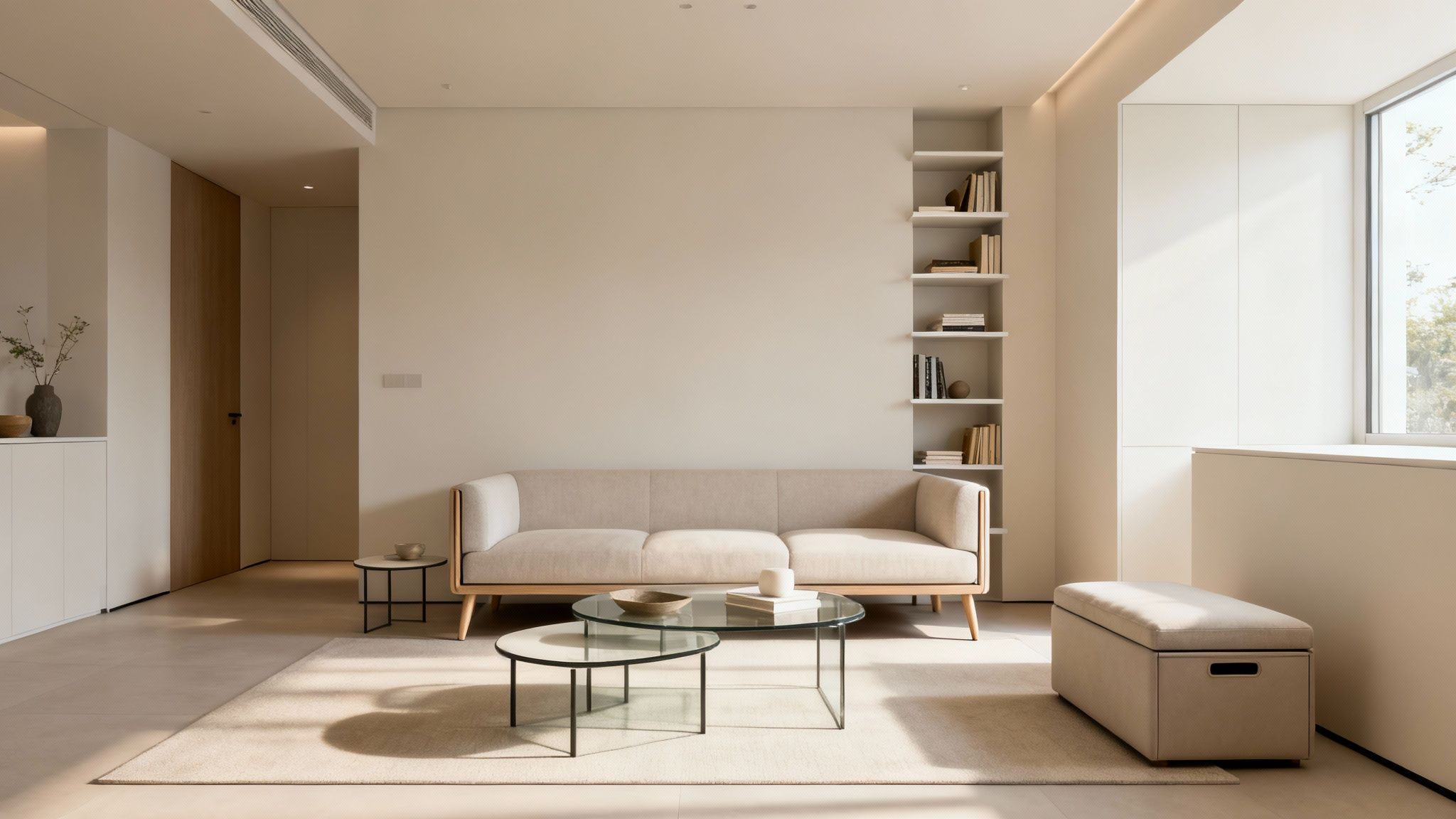
Prioritise Scale and Visual Weight
When you’re learning how to decorate a small living room, you quickly realise the physical size of your furniture is only half the battle. The other half is its visual weight—basically, how heavy an object looks. Bulky, dark furniture that sits squat on the floor can feel oppressive and instantly shrink a room.
The trick is to look for sofas and chairs with slender arms and, most importantly, visible legs. By lifting furniture off the floor, even by a few inches, you let light and air circulate underneath. This simple illusion makes the entire area feel more spacious.
Materials like glass and acrylic are your best friends here. A glass coffee table, for instance, does its job perfectly without adding any visual clutter at all. It almost vanishes, keeping your sightlines clear and the room feeling uncluttered.
Expert Tip: Make your furniture work harder. In a compact space, every item should ideally serve more than one purpose. Think of a stylish ottoman with hidden storage for stashing away blankets, or a set of nesting tables that can be expanded for guests and tucked away afterwards.
Go Vertical to Maximise Your Square Footage
When you’re short on floor space, the only way is up. Thinking vertically is a complete game-changer in small rooms because it draws the eye upward, creating an illusion of height and making the whole room feel larger than it is.
This means using your walls for everything they’re worth, for both storage and décor. Tall, narrow bookcases are brilliant as they offer masses of storage without eating up much of the floor. In the same way, floating shelves above the sofa or TV give you a spot for books, plants, and photos without taking up any precious surface space.
Consider a few of these vertical tricks:
- Ladder Bookcases: Their open-sided design feels much lighter and less imposing than traditional, boxy shelving units.
- Floating Media Units: Mounting your TV console on the wall frees up the floor space beneath, which immediately makes the area feel less cramped.
- Wall-Mounted Lighting: Ditch the bulky floor lamp for a chic wall sconce. You'll save a corner of your room and add a lovely layer of ambient light.
This move towards smart, stylish furnishing is something we're seeing more and more. There's a growing desire for affordable luxury, with people mixing budget-friendly staples with unique, characterful pieces. In fact, market research shows that sales of vintage-style and detailed furniture pieces shot up by 22% from 2023 to 2024, as homeowners look for personality without the hefty price tag. You can see more on small living room trends on RealHomes.com.
Finding the right furniture is all about balancing form and function, and you can get even more practical advice from our journal on small space decorating ideas. By carefully selecting pieces that are properly scaled, multi-functional, and vertically-minded, you can design a living room that’s both wonderfully practical and bursting with personality.
Using Colour and Light to Create Space
When you're working with a small living room, colour and light are your secret weapons. Seriously. Get them right, and you can trick the eye into seeing a space that feels open, airy, and much larger than it actually is. It's all about creating an illusion of depth and height.
This goes way beyond just painting everything white. It’s about a thoughtful approach to your colour palette and lighting plan, which is a cornerstone of successfully decorating a compact living space.
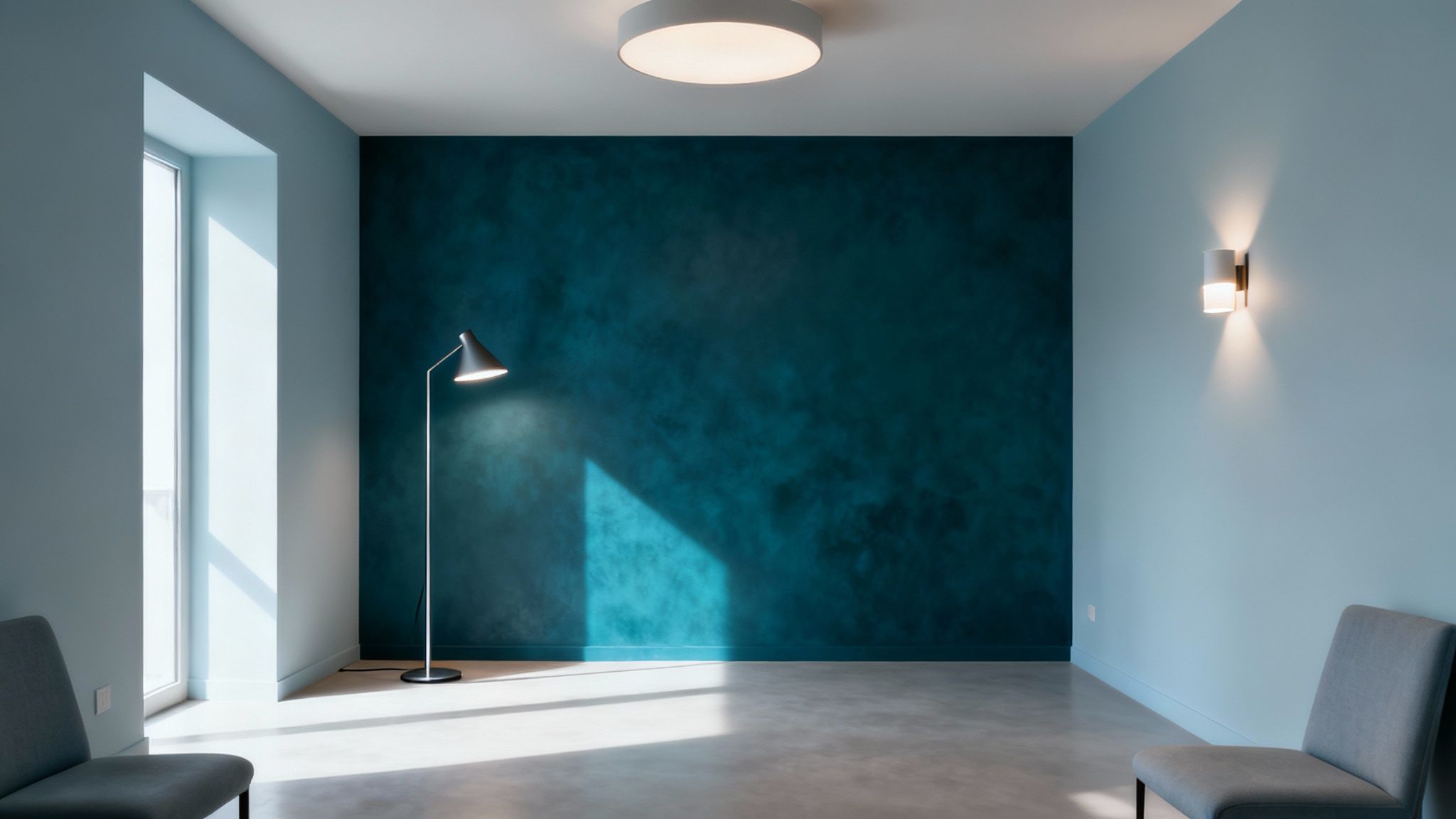
Harnessing the Power of Colour
The classic advice has always been to stick with light, cool colours. Think soft blues, pale greys, and gentle greens. These shades naturally recede, which makes the walls feel further away and gives you an instant sense of spaciousness. It’s a trick that’s been used for decades because, well, it works.
But there’s a new trend in the UK that flips this on its head: colour drenching. This is where you commit to a single, often moody, hue and paint everything—walls, skirting boards, door frames, even the ceiling. A deep navy or a rich forest green can blur the room’s boundaries, creating a sophisticated, jewel-box effect where you can’t quite tell where one surface ends and another begins.
Speaking of green, it's definitely having a moment. Recent data shows it was the most popular choice for UK living rooms last year, with shades from dark olive to emerald being favoured by around 22% of homeowners. Its connection to nature brings a bit of the outdoors in, which is fantastic for making a room feel more relaxing and expansive. You can dive deeper into these popular living room colours on CountryLiving.com.
Illuminate with Layered Lighting
Just as crucial as your paint choice is your lighting. A single, harsh overhead light is the enemy of a small space—it casts shadows in all the wrong places and makes the room feel flat and uninviting. The real secret is to layer your lighting to build depth, warmth, and different zones of activity.
A well-lit room always has three layers working in harmony:
- Ambient Lighting: This provides the room's overall glow. For low ceilings, a flush or semi-flush mount light is a much better choice than a low-hanging pendant.
- Task Lighting: This is for specific activities, like curling up with a book. A slim floor lamp tucked behind an armchair or a small lamp on a side table gives you focused light right where you need it.
- Accent Lighting: This is your chance to get creative and highlight features you love, like a piece of art or a beautiful plant. A small, adjustable spotlight or a picture light adds a touch of drama and guides the eye around the room.
By combining these three types, you create a dynamic and versatile lighting scheme. Wall sconces are particularly brilliant in small living rooms as they add beautiful ambient light without consuming any floor or table surface area.
For rooms that don't get much sunlight, a smart lighting strategy is non-negotiable. If you're struggling with a darker space, our guide on how to brighten a dark room is packed with more tips to help you transform it.
Smart Storage Solutions to Eliminate Clutter
Let's be honest, clutter is the sworn enemy of a small living room. It’s the fastest way to make a space feel chaotic, cramped, and far smaller than it actually is. The real secret to decorating a compact space effectively is finding a stylish home for everything you own.
This isn't just about plonking a bookshelf in the corner. It's about getting creative with clever, integrated storage that actually enhances your décor.

Think Vertically and Hide in Plain Sight
When you're short on floor space, your walls become your most valuable real estate. Using that vertical space isn't just a practical storage trick; it also draws the eye upward, which cleverly creates the illusion of a higher ceiling and a more open room.
Think about installing floor-to-ceiling shelving. These units can look fantastic framing a doorway or flanking a sofa, transforming an entire wall into a feature that’s both functional and beautiful. They’re the perfect spot for books, favourite objects, and even electronics, which helps keep other surfaces clear.
Beyond the obvious shelving, start looking for ways to hide your storage in plain sight.
- Attractive Baskets: I love using woven baskets for stashing away everything from blankets and magazines to kids' toys. Tucked beside an armchair or under a console table, they add a lovely, warm texture to the room.
- Decorative Boxes: On open shelves, a few stylish boxes can neatly conceal all those little bits and bobs—remote controls, coasters, charging cables—that create visual clutter.
- Smart Media Units: Always opt for a media console with closed cupboards or drawers. It's an absolute must for hiding that inevitable tangle of wires, gaming consoles, and other tech that can quickly make a space look messy.
A well-organised space is a serene space. The goal isn't just to hide your things, but to create a system where everything has a logical and accessible home, making it easier to relax and enjoy the room.
Adopt a Clutter-Free Mindset
Of course, even the best storage in the world is no match for too much stuff. Keeping a small living room organised often requires a real shift in mindset, starting with a ruthless decluttering session. You have to be honest with yourself about what you truly need, use, and love.
Once you’ve whittled things down, try adopting the ‘one in, one out’ rule. It's simple: for every new item that comes into the living room, something of similar size has to leave. This one habit is brilliant for preventing that slow, creeping accumulation of clutter that can undo all your hard work.
For anyone planning a bigger project, it's worth exploring clever storage ideas to build in while you renovate. These can provide permanent solutions that squeeze value from every last inch. By combining smart furniture with mindful habits, you'll create a small living room that feels both beautiful and incredibly liveable.
Adding Personality and Purpose to Your Décor
This is where the magic happens. The final touches are what turn a collection of furniture into a room that feels like you. But when you're working with a small living room, every single accessory needs to pull its weight. It's all about decorating with intention, choosing pieces that serve a purpose and show off your personality without adding to the clutter.
Create Space with Mirrors and Art
Mirrors are the oldest trick in the small-space book for a simple reason: they just work. Popping a large mirror on the wall opposite a window is a game-changer. It will bounce light all around the room and, more importantly, create a brilliant illusion of depth, making everything feel so much more open.
When it comes to art, my advice is often to go big. A jumble of little frames can make a small wall feel busy and chaotic. Instead, think about a single, large piece of art that really speaks to you. It creates an instant focal point and feels so much more sophisticated. If you're set on a collection of smaller pieces, make it look intentional. Our guide to creating gallery wall ideas will show you how to get that curated, stylish look.
Ground the Space with a Great Rug
One of the most common mistakes I see in small living rooms is a rug that’s way too small for the space. It ends up looking like a little postage stamp floating adrift, which visually shrinks the room and makes the furniture feel disjointed. A rug's job is to anchor the entire seating area and pull everything together.
A simple rule to live by: Your rug should be big enough so that at least the front two legs of your sofa and any armchairs are sitting on it. This one trick makes the whole layout feel cohesive and properly grounded.
Unless your room is truly tiny, you'll almost always need at least an 8x10 foot rug. Trust me, getting the scale right here will make your room feel bigger and more finished, not smaller.
Layer in Texture and Life
With the big items sorted, it's time to bring in the warmth and character. This is where texture becomes your best friend, stopping the room from feeling flat. Think about introducing a mix of materials.
- Cushions and Throws: Don't be afraid to mix it up. A plush velvet cushion next to a chunky woollen throw and some linen creates a really inviting, touchable feel on your sofa.
- Curtains: Go for floor-length curtains and hang the rod high and wide. This draws the eye upwards, creating an illusion of height while adding softness to the room.
- Plants: Nothing breathes life into a space quite like a bit of greenery. A tall, slim plant—like a fiddle leaf fig or a snake plant—adds a much-needed vertical element without eating up precious floor space.
Choosing the right accessories is about making thoughtful decisions that enhance your space. It's not about filling every gap, but about selecting items that add beauty and function.
Accessory Choices That Make a Difference
Here’s a quick look at how small tweaks in your accessory choices can have a big impact on the overall feel of your living room.
Ultimately, these final layers are what make the room feel complete and personal. By choosing each piece with care, you create a space that’s not just well-designed, but truly your own.
Your Small Living Room Questions, Answered
Even with a solid plan, decorating a small space can feel like a puzzle. You're not alone in wondering about the tricky bits! I've pulled together some of the most common questions I hear from people tackling their own compact living rooms, with straightforward advice to help you get it right.
What's the Best Colour for a Small Living Room?
Most people will tell you to stick with light, bright colours like off-white or a soft grey. They’re not wrong—these shades are brilliant at bouncing light around and making a room feel more open. But that's not the whole story.
Don't be afraid to go dark. A popular trend in the UK right now is 'colour drenching', where you paint everything—walls, skirting boards, even the ceiling—in a single, deep shade like navy or forest green. It sounds counterintuitive, but it works wonders. By blurring the boundaries of the room, you create a surprisingly cosy and sophisticated space that can feel bigger and more immersive.
How Should I Arrange Furniture in a Long, Narrow Room?
Whatever you do, avoid the classic 'bowling alley' look where all the furniture is pushed up against the long walls. That’s the quickest way to make a narrow room feel even longer and more awkward.
The trick is to break the room up into smaller, distinct zones. Try floating a small sofa and a couple of armchairs in the middle of the room, facing each other over a rug. This creates a dedicated conversation pit. Behind the sofa, a slim console table can act as a subtle divider. Now, the far end of the room is free for a different purpose—perhaps a small desk and chair, or a cosy reading nook with a floor lamp.
The goal is to break up that long, straight line. By pulling furniture away from the walls and creating smaller groupings, you encourage better flow and make the room feel much more balanced and inviting.
Is It Always a Mistake to Use Large Furniture?
Absolutely not! It's a common misconception. Often, one well-chosen large piece, like a corner sofa, can make a room feel far less cluttered than a collection of smaller, ditsy items. The key isn't size, it's scale.
Look for sofas with clean lines, slim arms, and legs that lift them off the floor. This creates a sense of airiness and space underneath. As long as you leave enough room to walk around it comfortably, a single, larger piece can anchor the space beautifully and offer plenty of seating without looking bulky.
How Can I Add Personality Without Creating Clutter?
This is all about being selective. You want to choose a few high-impact pieces that tell a story, rather than filling every surface with small knick-knacks.
Here are a few ideas:
- Hang one large, statement piece of art instead of a busy gallery wall.
- Use a beautifully framed mirror to bounce light around and create an illusion of depth.
- Bring in texture with a couple of plush cushions and a chunky throw in a cohesive colour scheme.
- Add a tall plant, like a fiddle-leaf fig, to draw the eye upwards and add a touch of life.
When every decorative piece is chosen with purpose, you can inject plenty of your own style into the room while keeping it feeling calm and uncluttered.

